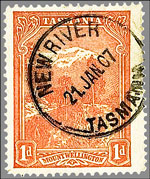Basis of the 'R' ratings
A rating scale and its application to known strikes was originally published by Campbell, Purvis and Viney, in Tasmania, The Postal History and Postal Markings(1962), supplemented by Part II (Avery, Edwards, Ingles((General Editor) and Purvis, 1975),who together examined some 1 million strikes (!) and proposed a 4-tier rarity classification. Keith Lancaster, in The Pictorial Stamps of Tasmania (1986,) reviewed and amended this work.
This census continues to use the original 4-tier rating scale, and applies Lancaster's ratings for individual cds. Ratings by Campbell, Purvis et al were used in the original Courier census but over time Lancaster's individual ratings have become widely used. As the Lancaster ratings are now more than 30 years out of date,the sum of current knowledge might alter some of the ratings for individual strikes. Perhaps the Census will shed more light on the true situation, hence its potential value to interested collectors.
- R - 25 to 50 copies known
- RR - 13 to 24 copies known
- RRR - 7 to 12 copies known
- RRRR - 1 to 6 copies known
How this census is organised
Ratings are based on those used in Lancaster (1986). In total there are 37 different cds classified as RRRR or RRR. Known examples are listed in separate web pages in alphabetical order, and details of the date of each example, source of the image, price and Auction House, if known are included. All examples from the original Courier survey are included and unfortunately only scans of copies of images are available. The quality of these black and white images is poor, but over time it should be possible to replace many with a better quality colour scan. We believe that the poor quality black and white image still serve a useful purpose as a means of identifying individual strikes.
Numbering system
Each example is given a consecutive number in order to provide a unique identifier and easy reference for every strike recorded. e.g. Br1 is the first example of Bronte listed in the Census.
A work in progress
It will take sometime to gather all available examples of these rare strikes. This census is a work in progress and it is hoped collectors will be patient as the census gradually becomes more complete.

Why collect cds on the Pictorials?
Collecting these postmarks has long had a staunch following. The large size of the Pictorials combined with the colours of most denominations make a wonderful background to show off a post mark. Many other stamps of this period were considerably smaller and strikes often miss the mark. Some 520 different cds were in use between 1899 and 1912, excluding the many variations in the largest Towns, Hobart, Launceston and Zeehan. Some were used for a short time only. There were 491 separate Post Offices but some changed names and lost or worn out date stampers resulted in re-issues and amendments.
This number of cancels present an achievable, if challenging target for collectors. Many are common so the beginning collector can assemble a respectable collection at a modest price, while the rarest present a more allusive challenge .There are options to collect similar strikes on the various values of the Pictorial issues, and the 'geographical' collector might add a few pictorial postcards showing scenes of the various Towns being collected.As many of the smaller towns no longer exists, a study of their postmarks offers an interesting insight into the social history of Tasmania.
Cancellation types on the Pictorials
The early researchers mentioned above devised a classification system for the cds as found on Pictorials. This system is used on the pages which follow as one of the key identifiers.
Type 1
- 1: date in two lines, with or without stops (circles stars of other small delimiting markings on either side of the Town name)
- 1a: As above but with 'Tasmania'abreviated to 'Tas'
- 1b:As type 1 but with an asterisk between the name and the date
Type 2
- 2: Date in one line. Month in three letters, year in two figures.
- 2a: As Type 2, but month in two letters, year in full.
- 2c: Date in one line. Cross pattee stops at each side.
Type 3
- Date and time on one line
Can you add to the Census?
If you have copies of any of the 3R or 4R cds on Pictorial, the TPS would like to have a scan for this census. Failing that, details of the strike including date, cds type, value of the stamp and any distinguishing features would be valuable.
Please contact the web master, Peter Allan, in the first instance. Your contributions will be treated with the up-most privacy. Alternatively, if you wish, your contribution can be publicly recorded on the web site

